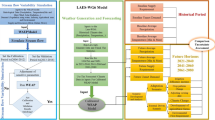Abstract
The paradigm of integrated water resources management requires coupled analysis of hydrology and water resources in a river basin. Population growth and uncertainties due to climate change make historic data not a reliable source of information for future planning of water resources, hence necessitating climate and landuse change impact studies. This work presents an integrated modeling approach by linking Soil and Water Assessment Tool (SWAT) and MODSIM. While SWAT produces hydrologic and water resources information, MODSIM provides a decision support system for water allocation. We used the coupled SWAT–MODSIM to analyze the effects of climate and cropping pattern changes on agricultural and hydroenergy production in the Karkheh River Basin, a semiarid region in south-west of Iran. Cropping patterns were considered by limiting the cereal production to 50 % (S1, near to historic), 17 % (S2), and 83 % (S3) of total agricultural areas. The future climate was provided by the Canadian Global Coupled Model (CGCM 3.1 version T63) for A1B, A2, and B1 scenarios. The results showed that based on future climate changes and landuse scenarios, wheat production had a large variation in five economically important agricultural regions ranging from 33,000 ton year−1 (S2-A1B) to 74,000 ton year−1 (S3-A2). Similarly, energy production, while increasing from 614 to 1,100 GWH in A2, decreased from 614 to 464 GWH in B1 climate scenario. Our analyses indicate that cropping pattern change can be used as an effective tool to adapt to the negative impacts of climate change.








Similar content being viewed by others
References
Abbaspour KC, Faramarzi M et al (2009) Assessing the impact of climate change on water resources in Iran. Water Resources Research 45:W10434. doi: 10.1029/2008WR007615
Ahmad MUD, Giordano M (2010) The Karkheh River basin: the food basket of Iran under pressure. Water Int 35(5):522–544
Ahmad MUD, Islam MA et al (2009) Mapping basin-level water productivity using remote sensing and secondary data in the Karkheh River Basin. Iran. Water Int 34(1):119–133
Arnold JG, Srinivasan R et al (1998) Large area hydrologic modeling and assessment—Part 1: model development. J Am Water Resour Assoc 34(1):73–89
Ashraf Vaghefi S, Mousavi SJ et al (2013) Analyses of the impact of climate change on water resources components, drought and wheat yield in the semi-arid Karkheh River Basin in Iran. doi:10.1002/hyp.9747
Bertsekas D (1991) Linear network optimization. MIT Press, Massachusetts
Dai TW, Labadie JW (2001) River basin network model for integrated water quantity/quality management. J Water Resour Plan Manag 127(5):295–305
De Azevedo LGT, Gates TK et al (2000) Integration of water quantity and quality in strategic river basin planning. J Water Resour Plan Manag 126(2):85–97
De Fraiture C, Cai XM et al (2003) Addressing the unanswered questions in global water policy: a methodology framework. Irrig Drain 52(1):21–30
Eckhardt K, Ulbrich U (2003) Potential impacts of climate change on groundwater recharge and streamflow in a central European low mountain range. J Hydrol 284(1–4):244–252
Farahani H, Oweis T (2008) Chapter I Agricultural water productivity in Karkheh River Basin. Improving on-farm agricultural water productivity in the Karkheh River Basin. Farahani H, Oweis T, Qadir M, Anthofer J, Siadat H, Abbasi F, Bruggeman A (eds) ICARDA, Aleppo, Syria. IV: +103
Faramarzi M, Abbaspour KC et al (2009) Modelling blue and green water resources availability in Iran. Hydrol Process 23(3):486–501
Fredericks JW, Labadie JW et al (1998) Decision support system for conjunctive stream-aquifer management. J Water Resour Plan Manag 124(2):69–78
Gosain AK, Rao S et al (2006) Climate change impact assessment on hydrology of Indian river basins. Curr Sci 90(3):346–353
Hanratty MP, Stefan HG (1998) Simulating climate change effects in a Minnesota agricultural watershed. J Environ Qual 27(6):1524–1532
Iran Water and Power Resources Development Co (IWPC) (2010) Systems approach to Karkheh River Basin water resources projects (Available in Persian). Technical Report, IWPC Research Department, Tehran, Iran
Jamali S, Abrishamchi A, Madani K (2013) Climate change and hydropower planning in the Middle East: implications for Iran’s Karkheh hydropower systems. J Energy Eng 139(3):153–160
Jha M, Pan ZT et al (2004) Impacts of climate change on streamflow in the Upper Mississippi River Basin: a regional climate model perspective. J Geophy Res Atmos 109:D09105. doi: 10.1029/2003JD003686
Jha M, Arnold JG et al (2006) Climate change sensitivity assessment on Upper Mississippi River Basin streamflows using SWAT. J Am Water Resour Assoc 42(4):997–1015
Keshavarz A, Ashrafi S et al (2005) Water allocation and pricing in agriculture of Iran. National Academies Press, Washington
Labadie JW (1995) MODSIM: river basin network flow model for conjunctive stream-aquifer management. Program User Manual and Documentation. Colorado State University, Boulder
Marjanzadeh S, De Fraiture C et al (2010) Food and water scenarios for the Karkheh River Basin. Iran Water Int 35(4):409–424
Marshall E, Randhir T (2008) Effect of climate change on watershed system: a regional analysis. Clim Change 89(3–4):263–280
Masih L, Ahmad M et al (2009) Analysing streamflow variability and water allocation for sustainable management of water resources in the semi-arid Karkheh river basin, Iran. Phys Chem Earth 34(2009):329–340
Oweis H,Farahani M et al (2008) Improving on-farm agricultural water productivity in the Karkheh River Basin. Research report no. 1: a compendium of review papers. ICARDA, Aleppo, Syria, iv:+103
Rijsberman FR (2006) Water scarcity: fact or fiction? Agric Water Manag 80(1–3):5–22
Shourian M, Mousavi SJ et al (2008) Basin-wide water resources planning by integrating PSO algorithm and MODSIM. Water Resour Manag 22(10):1347–1366
Stone MC, Hotchkiss RH et al (2001) Impacts of climate change on Missouri River Basin water yield. J Am Water Resour Assoc 37(5):1119–1129
Author information
Authors and Affiliations
Corresponding author
Rights and permissions
About this article
Cite this article
Ashraf Vaghefi, S., Mousavi, S.J., Abbaspour, K.C. et al. Integration of hydrologic and water allocation models in basin-scale water resources management considering crop pattern and climate change: Karkheh River Basin in Iran. Reg Environ Change 15, 475–484 (2015). https://doi.org/10.1007/s10113-013-0573-9
Received:
Accepted:
Published:
Issue Date:
DOI: https://doi.org/10.1007/s10113-013-0573-9




